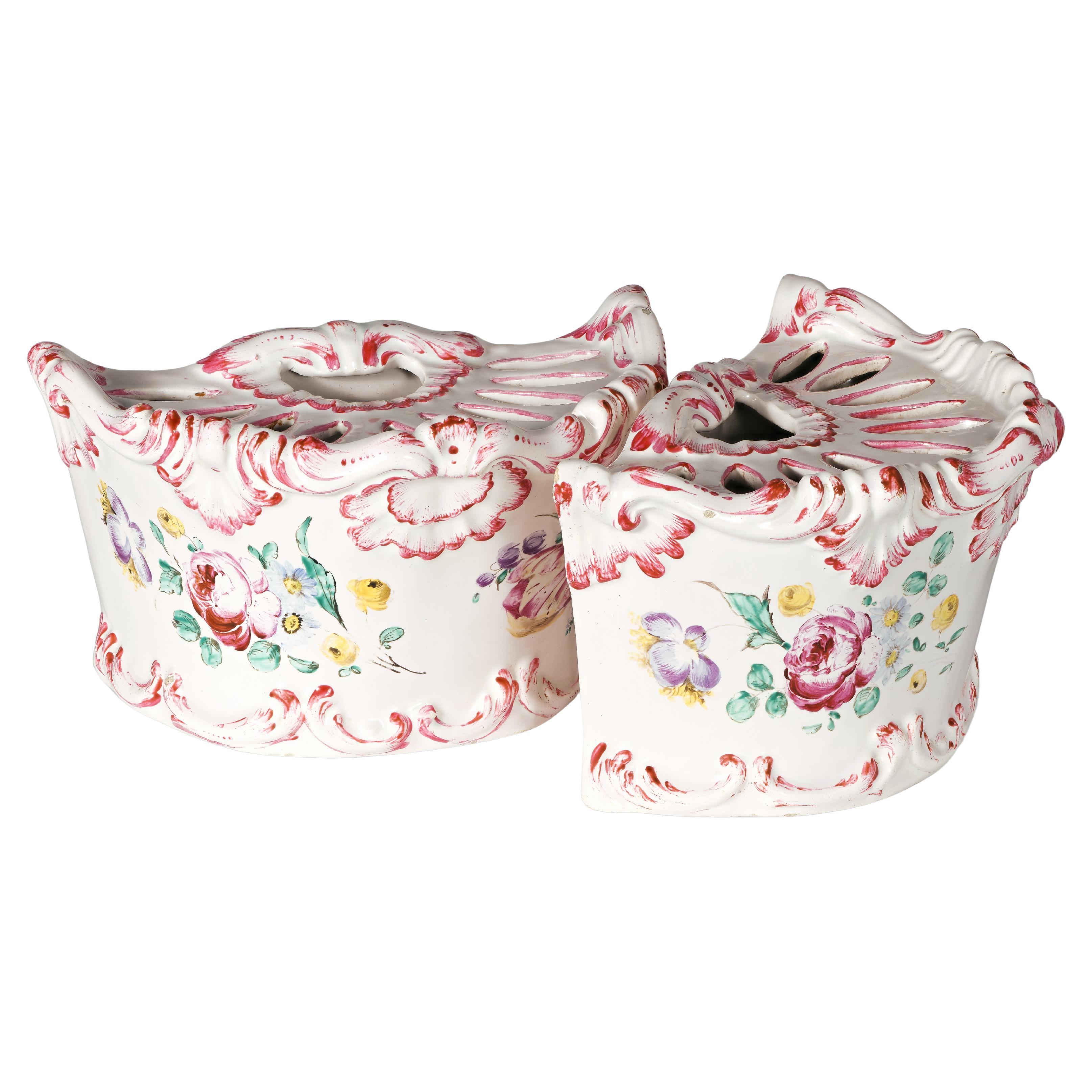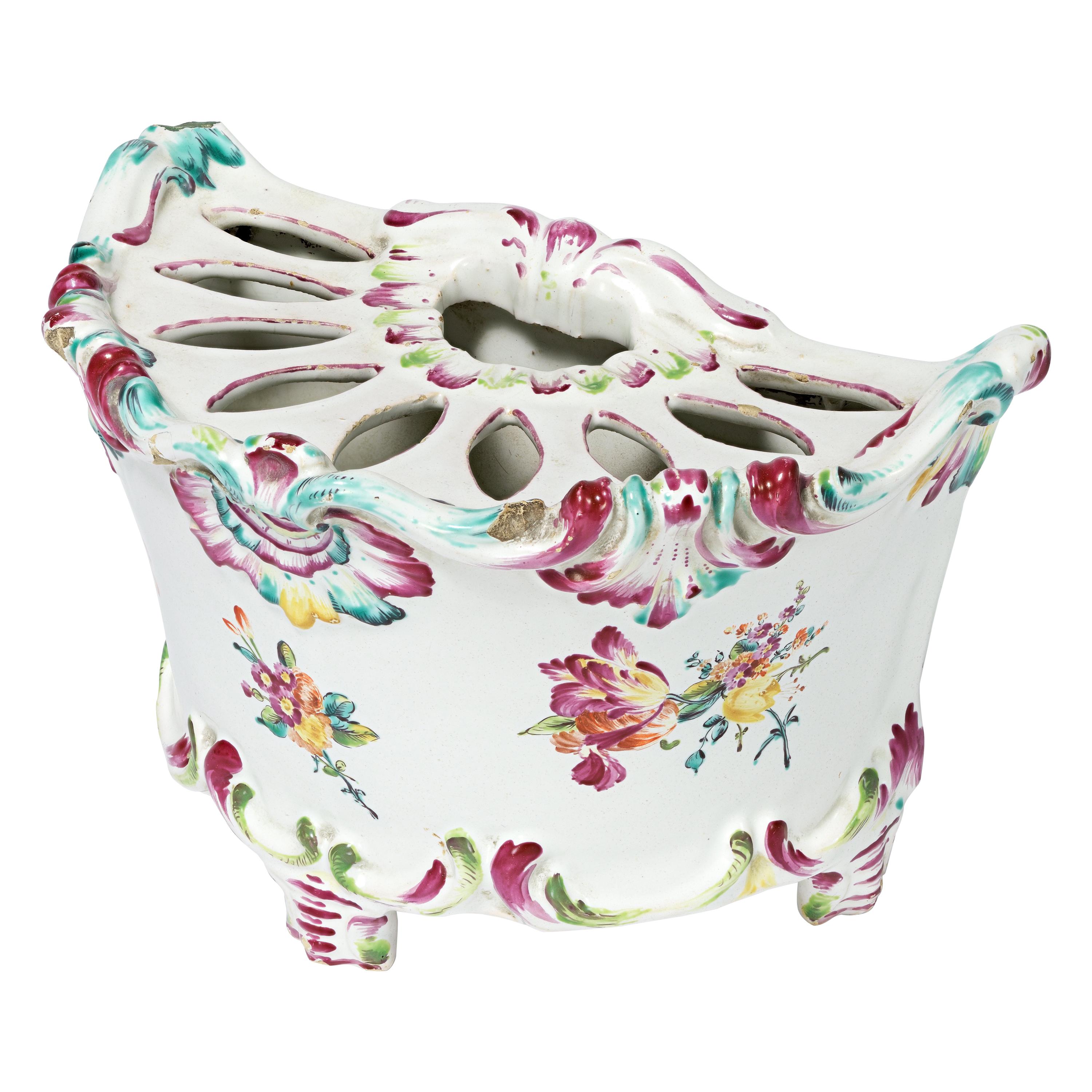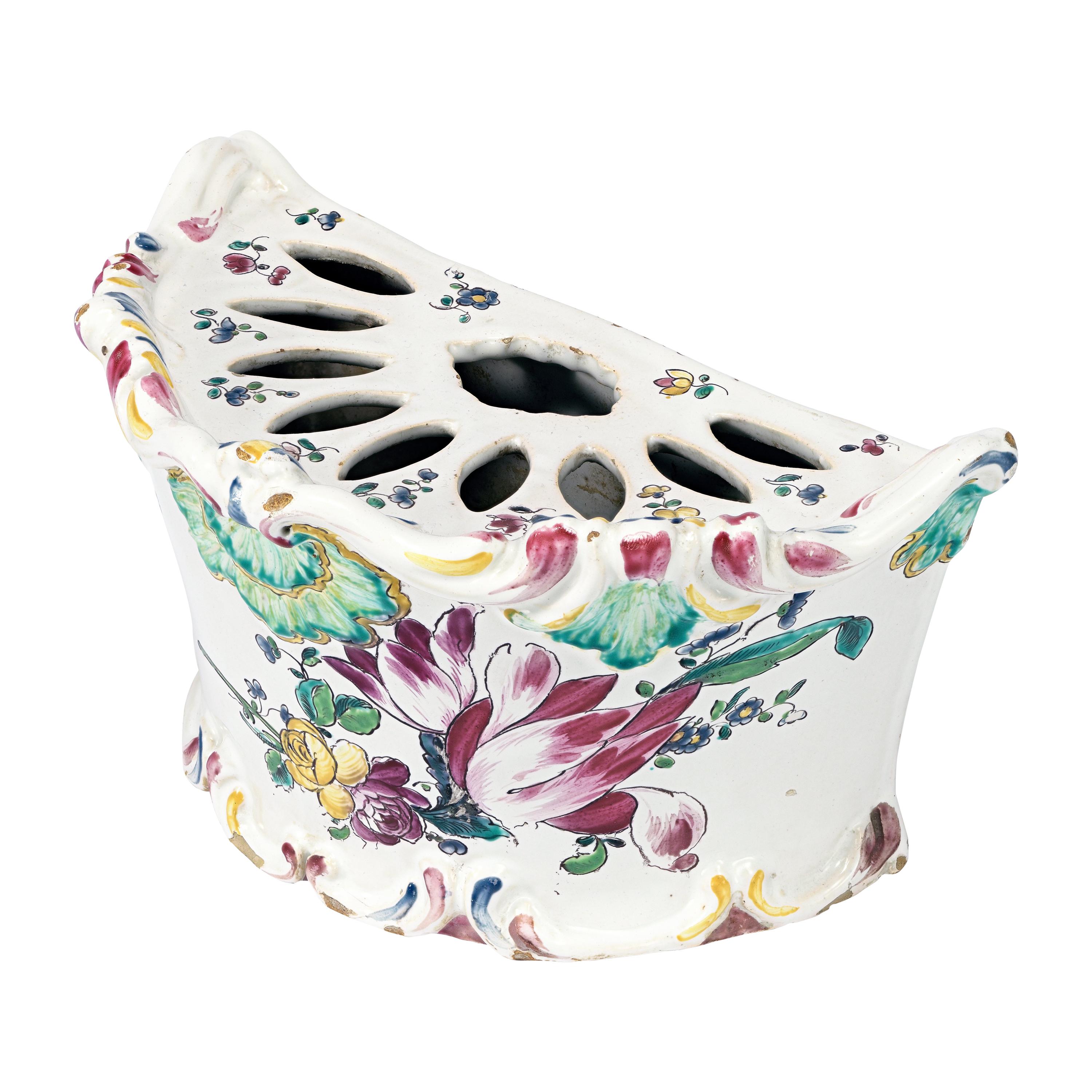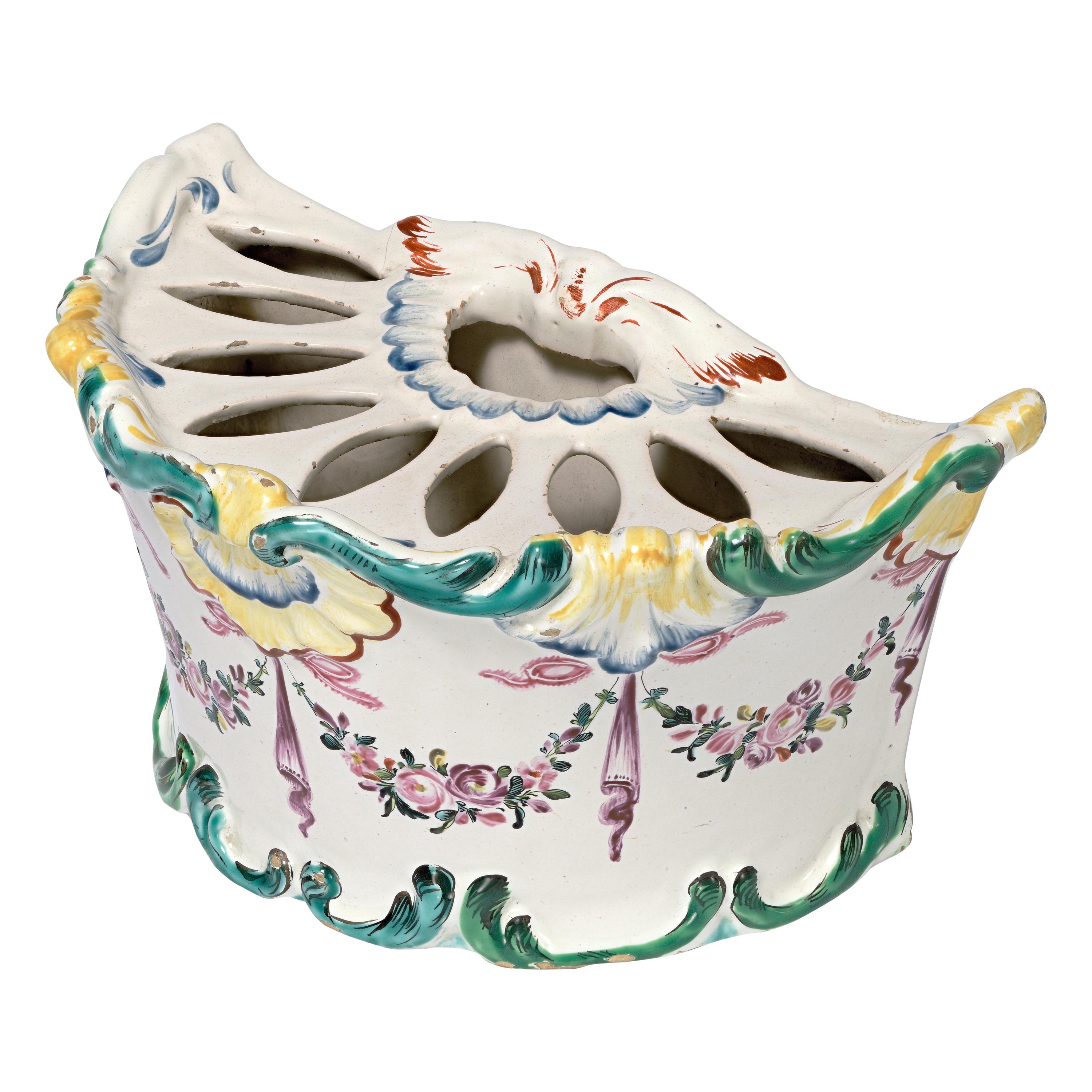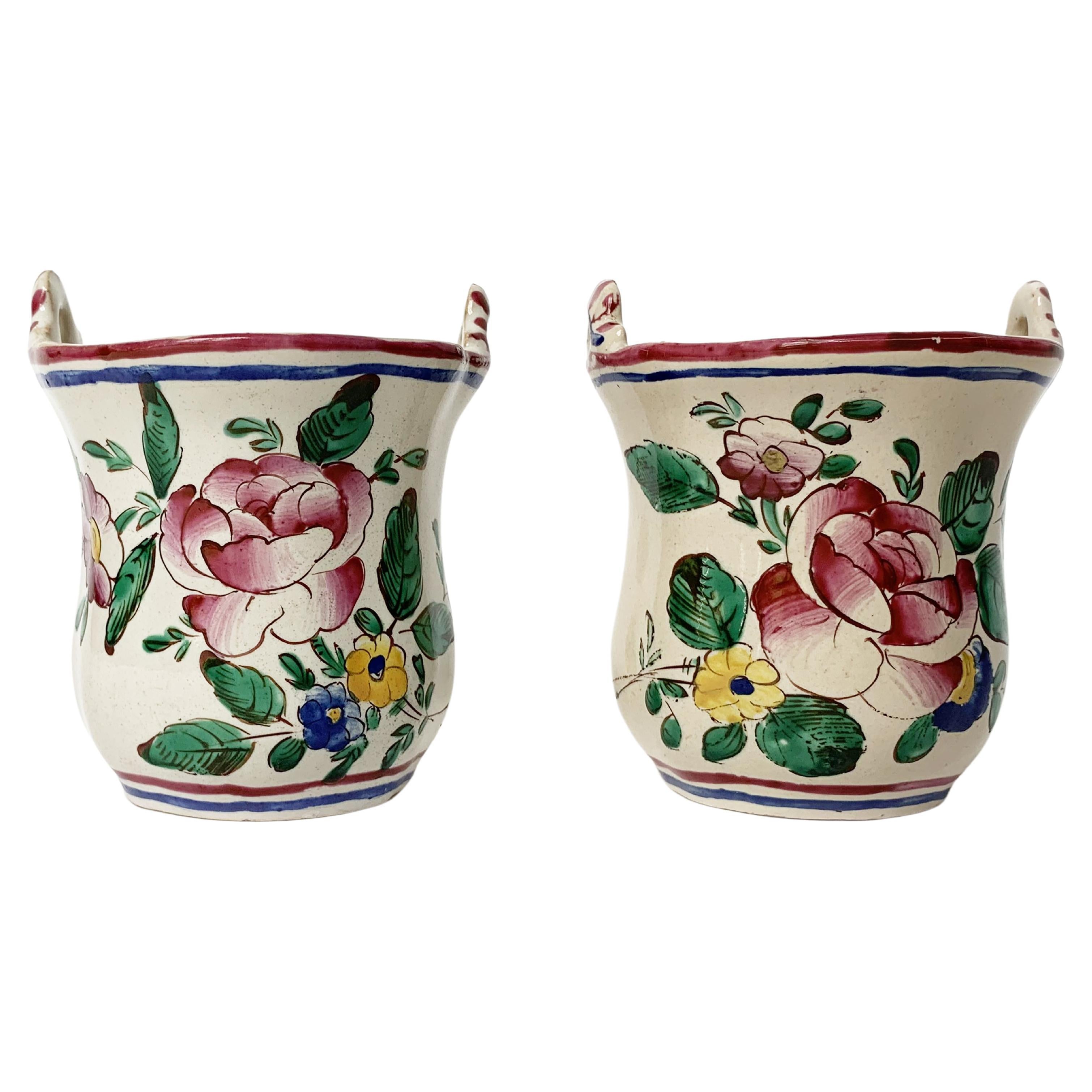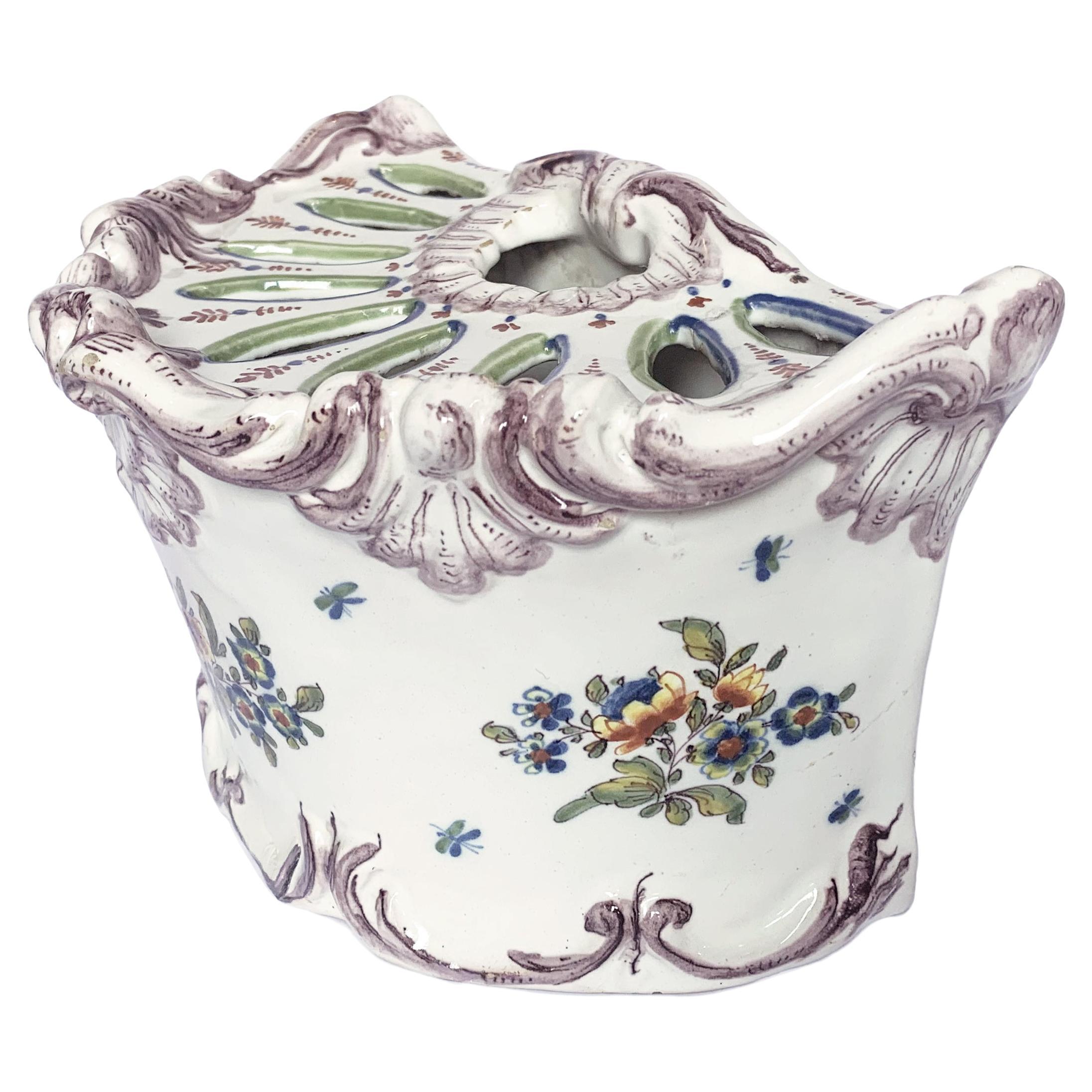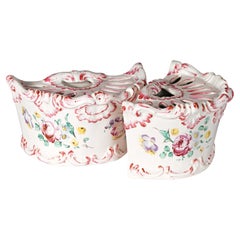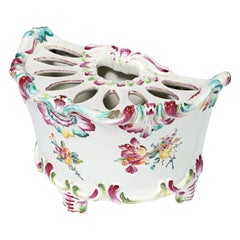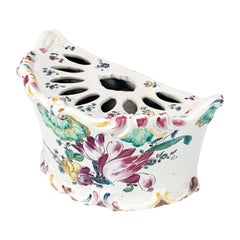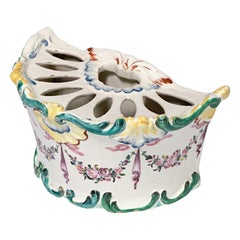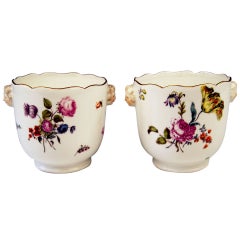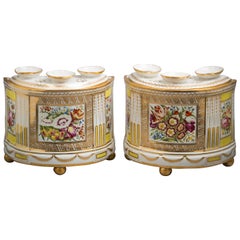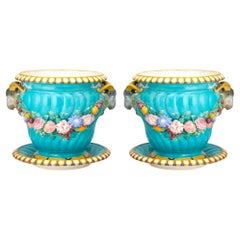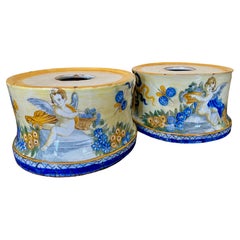Items Similar to Pair of Ancient Italian Maiolica Flower Pots Milan, Rubati Factory, 1770 circa
Video Loading
Want more images or videos?
Request additional images or videos from the seller
1 of 22
Pair of Ancient Italian Maiolica Flower Pots Milan, Rubati Factory, 1770 circa
$7,173.69per set
£5,310.70per set
€6,000per set
CA$9,926.60per set
A$10,943.85per set
CHF 5,725.47per set
MX$134,260.70per set
NOK 72,072.31per set
SEK 67,399per set
DKK 45,704.32per set
About the Item
Maiolica flower pot “a mezzaluna”
decorated with trompe l’oeil
Pasquale Rubati Factory
Milan, circa 1770
Measures: each 4.7 in (cm 12) x 5 in (cm 12.8) x 8.7 in (cm 22.4)
lb 1.76 each (kg 0.8)
State of conservation, intact with slight chipping due to use in relief parts
A rare example of a flower pot “a mezzaluna” produced by the manufactory of the refined painter Pasquale Rubati, who opened a factory in Milan in 1756 to compete with Felice Clerici.
The flower pot with a complex, as well as original and practical, shape was used to hold flowers while creating an orderly arrangement. As it could also be leant against the wall, its use went beyond simple table centerpieces, but rather it could also be placed in functional and decorative locations.
The Maiolica is decorated with a rocaille relief to adorn the edges. The upper part is perforated in a radial pattern to contain and support the flowers. The mold, indicated in the original inventories as “fioriere a mezzaluna”, was notedly used by the Milanese manufactories of the 18th century, as demonstrated by some of the specimens preserved in the museum of applied arts of the Sforzesco Castle in Milan. (See R. Ausenda (edited by), Musei e Gallerie di Milano. Museo d’Arti Applicate. Le ceramiche. Tomo secondo, Milano 2001, p. 425, n. 409 and n. 41.)
The polychrome decoration shows two medallions painted in green with figures of wayfarers, joined together by garlands of minute flowers. The wayfarers and the architectures of the ruin style are placed in a symbolic landscape, painted with brown manganese brushstrokes and shaded with more marked brushstrokes and veiled with the same green background.
The painter freely draws the subject of the planters from the engravings of Callot, Della Bella or Piranesi, reinterpreting it with elegance and with great technical expertise. Such meticulousness, comparable to porcelain painting, especially in the resulting small flowers of the garlands, also allows the attribution of the works to the Pasquale Rubati manufactory. A specimen of a flower pot with a brown landscape is kept in the museum of Villa Cagnola in Varese. Ausenda R. in AA. VV. La collezione Cagnola, II, arazzi, sculture, mobili, ceramiche, Busto Arsizio 1999, p. 196 n. 110.
The theme of the wayfarer and of the pilgrimage is one of the most iconographic elements present in 18th century imagery. The taste, generated by the charm of the Arcadian landscape inhabited by shepherds-wandering poets, finds, indeed, wide response precisely in the search for views and emotions that almost always populated the expectations of grand tour travellers ever since the 17th century.
In ceramic production all this is well evidenced by the success of the almost Coeval maolica of Filippo Comerio in Faenza, whose inventions skilfully sketched in manganese and veiled in emerald green, achieved such a great success at the time, so as to change the name of the material from "green Savy" to "green Comerio". (See C. Ravanelli Guidotti, La Fabbrica Ferniani. Ceramiche faentine dal barocco all’ecclettismo, Milano 2009, pp. 259-266.)
As well as the illustrious antecedents with "wayfarers and architectures" produced in Pavia by the painters Africa at Pavese manufactories "Imbres" and "Rampini". (E. Pellizzoni, M. Forni., S. Nepoti, La Maiolica di Pavia tra Seicento e Settecento, Milano 1997)
Or finally, those with "landscapes with ruins and wayfarers" so popular in the shops of Castelli d'Abruzzo. (See, for example, the landscapes of Aurelio Anselmo Grue in F. Filipponi, Aurelio Anselmo Grue, la Maiolica del settecento tra Castelli e Atri, Castelli 2015)
Maiolica and porcelain production in the 18th century belonged mainly to the great royal families or in any case to the noble families who made the manufacture of ceramic works a source of prestige. In Milan, under Maria Teresa of Austria, the time period witnessed a real opening to new industrialists who, by Virtue of the privatizations granted by the government, assumed a real business risk, giving life, albeit not without conflict, to flourishing factories and to production which was among the most elegant and most requested at the moment and which still today remains object of collection.
- Creator:Pasquale Rubati (Manufacturer)
- Dimensions:Height: 4.73 in (12 cm)Width: 8.82 in (22.4 cm)Depth: 5.04 in (12.8 cm)
- Sold As:Set of 2
- Style:Rococo (Of the Period)
- Materials and Techniques:Maiolica,Other
- Place of Origin:
- Period:1770-1779
- Date of Manufacture:circa 1770
- Condition:Wear consistent with age and use. Intact with slight chipping due to use in relief parts.
- Seller Location:Milano, IT
- Reference Number:1stDibs: LU4352214054932
About the Seller
4.3
Vetted Professional Seller
Every seller passes strict standards for authenticity and reliability
Established in 1860
1stDibs seller since 2018
21 sales on 1stDibs
Associations
International Confederation of Art and Antique Dealers' Associations
- ShippingRetrieving quote...Shipping from: Milano, Italy
- Return Policy
Authenticity Guarantee
In the unlikely event there’s an issue with an item’s authenticity, contact us within 1 year for a full refund. DetailsMoney-Back Guarantee
If your item is not as described, is damaged in transit, or does not arrive, contact us within 7 days for a full refund. Details24-Hour Cancellation
You have a 24-hour grace period in which to reconsider your purchase, with no questions asked.Vetted Professional Sellers
Our world-class sellers must adhere to strict standards for service and quality, maintaining the integrity of our listings.Price-Match Guarantee
If you find that a seller listed the same item for a lower price elsewhere, we’ll match it.Trusted Global Delivery
Our best-in-class carrier network provides specialized shipping options worldwide, including custom delivery.More From This Seller
View AllMaiolica flower pots Samson & Fils Factory, France, late 19th century
By Emile Samson
Located in Milano, IT
Maiolica flower pots “a mezzaluna”
Samson & Fils Factory
Montreuil-sous-Bois, France, late 19th century
They measure 4.72 in in height x 8.66 x 5.03 (12 cm x 22 x 12,8)
Weight: 1.88...
Category
Antique Late 19th Century French Rococo Planters, Cachepots and Jardinières
Materials
Maiolica
Rococo Italian Maiolica Flower Pot Pasquale Rubati, Milano, 1770 circa
By Pasquale Rubati
Located in Milano, IT
Maiolica flower pot “a mezzaluna” with support feet
decorated with little bunches of flowers
Pasquale Rubati Factory
Milan, circa 1770
5.5 in X ...
Category
Antique 1770s Italian Rococo Ceramics
Materials
Maiolica
Ancient Maiolica Flower Pot Pasquale Rubati Factory, Milan Circa 1770
By Pasquale Rubati
Located in Milano, IT
Maiolica flower pot “a mezzaluna” decorated with tulip
Pasquale Rubati Factory
Milan, circa 1770.
Measures: 4.7 in x 4.7 in x 8.6 in
12 cm x 12...
Category
Antique 1770s Italian Rococo Ceramics
Materials
Maiolica
Italian Maiolica Flower Pot Garlands of Flowers, P. Rubati, Milano, 1770 circa
By Pasquale Rubati
Located in Milano, IT
Maiolica flower pot “a mezzaluna”
decorated with garlands of flowers
Pasquale Rubati Factory
Milan, circa 1770
Measures: 4.7 in x 5 in x 8.8 in
...
Category
Antique 1770s Italian Rococo Ceramics
Materials
Maiolica
Small Maiolica Flower Pots, Ferretti Manufacture, Lodi, circa 1770-1780
By Antonio Ferretti
Located in Milano, IT
Two maiolica flower pots
Antonio Ferretti Manufacture
Lodi, Circa 1770 - 1780
Maiolica polychrome decorated “a piccolo fuoco” (third fire)
The...
Category
Antique 1770s Italian Rococo Ceramics
Materials
Maiolica
Maiolica flower pot "a mezzaluna," Pasquale Rubati Factory, Milan, circa 1770
By Pasquale Rubati
Located in Milano, IT
Majolica flower pot "crescent" decorated in manganese
Pasquale Rubati Factory
Milan, c. 1770
4.92 in x 8.66 in x 5,31 in
12.5 cm x 22 cm X 13.5 cm
Weight: 2.29 lb (1039 g)
State of conservation: intact with slight chipping due to use in relief parts
A rare example of a flower pot "a mezzaluna" produced by the manufactory of the refined painter Pasquale Rubati, who opened a factory in Milan in 1756 to compete with Felice Clerici...
Category
Antique 1770s Italian Rococo Ceramics
Materials
Maiolica
You May Also Like
Meissen Pair of Cachepots Planters Flower Blossoms Rococo Period c. 1750
By Meissen Porcelain
Located in Vienna, AT
Meissen gorgeous pair of cachepots / planters stunningly decorated with flower blossoms, made in Rococo Period / circa 1750.
The white porcelain ...
Category
Antique 18th Century and Earlier German Rococo Porcelain
Materials
Porcelain
$2,845 Sale Price / set
29% Off
Pair of English Porcelain Demilune Boughpots and Covers, Coalport, circa 1820
By Coalport Porcelain
Located in New York, NY
Pair of yellow ground English porcelain demilune boughpots and covers, Coalport, circa 1820.
Category
Antique Early 19th Century English Planters, Cachepots and Jardinières
Materials
Porcelain
Striking Pair Minton Style Porcelain Continental Majolica Jardinieres/ Stands
Located in Tarry Town, NY
This striking pair of Minton-style porcelain Continental Majolica jardinieres with stands embodies elegance and rich decorative appeal. Each jardiniere showcases a vibrant turquoise ...
Category
Antique 1880s French Planters, Cachepots and Jardinières
Materials
Porcelain
$4,000 Sale Price / set
20% Off
Italian Castelli Majolica Bases, circa 1800
By Castelli
Located in CH
Italian Castelli majolica bases, Circa 1800.
This pair of bases for large vases are a typical example of the high quality manufacturing of the Caste...
Category
Antique 19th Century Italian Rococo Pottery
Materials
Ceramic
Pair of French Late 18th Century Paris Porcelain Cachepots with Floral Décor
Located in Atlanta, GA
A pair of French Louis XVI period Paris porcelain cachepots from the late 18th century, with hand-painted floral décor and gilt accents. Created in France during the short reign of K...
Category
Antique Late 18th Century French Louis XVI Porcelain
Materials
Porcelain
Pair of Chinese Export Polychrome Porcelain Cachepots, 18th Century
Located in El Monte, CA
This pair of 18th century Chinese Export polychrome porcelain cachepot are an exceptional example of antique porcelain made by skilled Chinese artisans for the European market. A sca...
Category
Antique 18th Century Chinese Chinese Export Planters, Cachepots and Jard...
Materials
Porcelain
More Ways To Browse
Trompe L Oeil Ceramics
Ancient Pot
Castelli Maiolica
Mason Ironstone Chinoiserie
Masons Patent Ironstone
Spanish Earthenware
Majolica Fruit
Swedish Ceramics Black Vase
Chinese Porcelain Chargers
Portuguese Silver Plate
Hand Painted Japanese Plate
Green Mid Century Pottery Plate
Spanish Ceramic Plate
Ceramic Plate Signed
Japanese Charger Blue And White
Mason Ironstone Plates
Japanese Imari Bowl
Chinese Blue And White Charger
